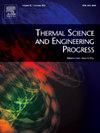热气候条件下太阳能辅助热电联产系统的多目标优化:经济与环境评价
IF 5.1
3区 工程技术
Q2 ENERGY & FUELS
引用次数: 0
摘要
该研究调查了一种太阳能化石燃料热电联产系统,该系统设计用于在炎热气候下发电、淡水、氢气和氧气。该系统由多个组件组成,包括布雷顿循环、热回收蒸汽发生器、汽轮机、抛物面槽集热器、海水淡化装置、有机朗肯循环和聚合物电解质膜电解槽。优化方法采用NSGA-II,旨在最大限度地提高能源效率,同时最小化年度总成本。进行了综合分析,包括能源、能源、经济、环境、消耗经济和消耗环境评估。最优结果表明,燃气轮机进口温度和空压机压力比越高,火用效率越高,太阳能水分数越高,火用效率越低。消耗经济和消耗环境分析表明,DB具有最高的消耗破坏成本率,而CC具有最大的消耗破坏生态影响率。相比之下,太阳能领域表现出最低的能源破坏成本和最小的生态影响。电力、淡水和氢氧的生产成本分别为0.0378美元/kWh、2.2346美元/m3和4.0139美元/kg。相应的生态影响率分别为0.0206 Pts/kWh、0.7447 Pts/m3和1.2249 Pts/kg。这些发现从多个角度全面概述了该系统的性能和优化,突出了其经济和环境可行性。本文章由计算机程序翻译,如有差异,请以英文原文为准。
Multi-objective optimization of a solar-assisted cogeneration system in hot climate: An exergoeconomic and exergoenvironmental assessment
The research investigated a solar-fossil fuel cogeneration system designed to generate power, freshwater, and hydrogen and oxygen in a hot climate. The system comprises multiple components, including the Brayton cycle, heat recovery steam generator, steam turbine, parabolic trough collectors, desalination unit, organic Rankine cycle, and a polymer electrolyte membrane electrolyzer. The optimization approach employed the NSGA-II, aiming to maximize exergy efficiency while minimizing total annual cost. Comprehensive analyses, including energy, exergy, economic, environmental, exergoeconomic, and exergoenvironmental assessments, were conducted. The optimal results indicated that exergy efficiency improved with higher gas turbine inlet temperatures and air compressor pressure ratios, but declined with increasing solar water fractions. Exergoeconomic and exergoenvironmental analyses identified that DB as having the highest exergy destruction cost rate, while the CC exhibited the largest exergy destruction ecological impact rate. In contrast, the solar field demonstrated the lowest cost rate of exergy destruction and minimal ecological impact. The production costs for power, freshwater, and hydrogen–oxygen were determined to be 0.0378 $/kWh, 2.2346 $/, and 4.0139 $/kg, respectively. The corresponding ecological impact rates were 0.0206 Pts/kWh, 0.7447 Pts/, and 1.2249 Pts/kg. These findings provide a thorough overview of the system’s performance and optimization from multiple perspectives, highlighting its economic and environmental viability.
求助全文
通过发布文献求助,成功后即可免费获取论文全文。
去求助
来源期刊

Thermal Science and Engineering Progress
Chemical Engineering-Fluid Flow and Transfer Processes
CiteScore
7.20
自引率
10.40%
发文量
327
审稿时长
41 days
期刊介绍:
Thermal Science and Engineering Progress (TSEP) publishes original, high-quality research articles that span activities ranging from fundamental scientific research and discussion of the more controversial thermodynamic theories, to developments in thermal engineering that are in many instances examples of the way scientists and engineers are addressing the challenges facing a growing population – smart cities and global warming – maximising thermodynamic efficiencies and minimising all heat losses. It is intended that these will be of current relevance and interest to industry, academia and other practitioners. It is evident that many specialised journals in thermal and, to some extent, in fluid disciplines tend to focus on topics that can be classified as fundamental in nature, or are ‘applied’ and near-market. Thermal Science and Engineering Progress will bridge the gap between these two areas, allowing authors to make an easy choice, should they or a journal editor feel that their papers are ‘out of scope’ when considering other journals. The range of topics covered by Thermal Science and Engineering Progress addresses the rapid rate of development being made in thermal transfer processes as they affect traditional fields, and important growth in the topical research areas of aerospace, thermal biological and medical systems, electronics and nano-technologies, renewable energy systems, food production (including agriculture), and the need to minimise man-made thermal impacts on climate change. Review articles on appropriate topics for TSEP are encouraged, although until TSEP is fully established, these will be limited in number. Before submitting such articles, please contact one of the Editors, or a member of the Editorial Advisory Board with an outline of your proposal and your expertise in the area of your review.
 求助内容:
求助内容: 应助结果提醒方式:
应助结果提醒方式:


